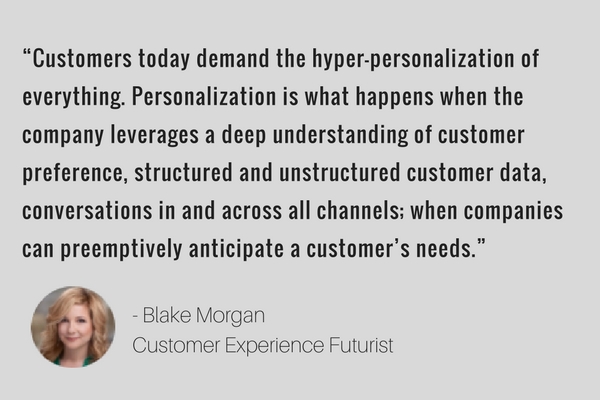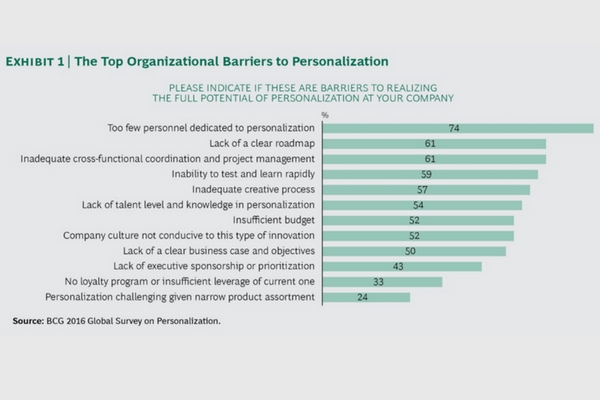Website personalization has been dominating recent client conversations and for good reason. Our clients are digital savvy and understand that available technical capabilities allow them to market to their various customer segments in more personalized, but still cost-effective ways. Our clients are reading articles on AdAge like Marketers cite personalization as most important to marketing in coming years which states that over "one-third of marketers said personalization will be the key going forward."
An article on HubSpot states that marketers who are personalizing their web experiences and are able to quantify the difference see a 19% uplift in sales on average. Personalization means being relevant to the specific needs of whoever is visiting your site (or seeing your advertising, getting your emails, etc.) - however, whenever and wherever they visit. Ultimately, the goals are to better understand your customers and optimize your website conversion rates at the same time. I think Blake Morgan summarized it well when she stated in a recent Forbes article: 
If There's No Struggle, There's No Progress
However, there was a recent report from Adobe that states that 60% of marketers struggle to personalize content in real time, yet 77% believe real-time personalization is crucial. In addition, a recent BCG publication identified the number one barrier to personalization is "too few personnel dedicated to personalization." Number two is "lack of a clear roadmap".
So, what steps can we take to help our clients establish that roadmap and guide them through this vital process in today's digital world?
Learn To Walk Before You Can Run
Like many things in the marketing space, it all starts with the fundamentals and having a clear path towards success:
- What are the goals, strategies for achieving those goals and how have the previous tactics helped achieve those?
- What are the KPIs that establish if we have achieved those goals for our clients? At times our clients will need help in establishing these. If that's the case, we can work with our clients' historical data and establish goals for upcoming campaigns to help justify the ROI.
- What is the historical quantitative (e.g. analytics) and qualitative (e.g. focus groups) data around the various customer segments and the funnels established? Are there any key drop off points within that funnel for a segment that present itself for opportunities for personalization?
From That Day On, If I Was Going Somewhere, I Was Running
Once we establish the digital marketing fundamental metrics and have a solid marketing infrastructure in place, we can start to experiment with personalization and A/B testing for each customer segment and persona. At the core, this should be a research exploration to better understand customer behavior and understand how to move the needle in the right way for each group. Depending on your perspective, this is where some of the fun parts start to happen.
Personalization is much more than something that you just set and forget. We leverage the scientific method by taking our best attempt at fixing the issue with our experienced team and then see how well it performs. We can continually tweak the UX, creative design and code to help understand customer behavior and how to best optimize for it. The appetite for this often comes down to the client's desire to constantly change the site to optimize it for the best results. Those that see the best results are the ones that are willing to experiment with new concepts and constantly monitor for both the positive and negative effects.
This has become much more cost effective and streamlined than ever before. The past couple of years has seen a wave of new products that make changing copy, assets, modules and templates for various webpages much less cumbersome. However, some of this will depend on the personalization engine that will be guiding this.
Ambition Is A Dream With A Personalization Engine
One of the other big factors that will determine the solution at play is understanding any current software including the CMS or CRM systems already in place. Many of the top CMSs on the market either have personalization engines built into their infrastructure or offer them as an add-on to integrate with a clients existing site. Many of the CMSs that our clients purchase fall into this category. Popular ones like Sitecore, Episerver, Acquia and Adobe Experience Manager all will tout their personalization capabilities.
If our client sites are not hosted on one of the many CMSs that offer personalization, there are still vendors out there that specialize in this area. CRM Solutions like Marketo, Salesforce, Oracle’s Maximyser and experimentation platforms like Optimizely, Evergage and Omniconvert are personalization engines that allow users to essentially serve up specific pages based on the rules established.
The Possibilities Are Numerous Once We Decide To Act And Not React.
In the past we were able to create a variety of web landing pages to handle a variety of "personalized" experiences that included:
- Paid media campaigns
- Email campaigns
- Geolocation
- Site referrer
- Time of day
However, creating these with modern tools is becoming much more streamlined (ie. lower cost). They take many of the repetitive tasks of UX, UI and development away and empower the marketer with centralized controls to handle these tasks. In addition, the modern personalization engines have "brains" now that are leveraging data (it's all "big data" these days) that track user demographics and behavior within the site.
If a user leaves the site and then returns the next day, week, month, year, etc. or on different devices there are ways in which you can treat this user differently. In addition, maybe you have identified a variety of goals within the site that where you want to track user behavior. The personalization engines can start to track that behavior and either reward or encourage users down the funnel within the site based on the rules that the team has set forth. In addition, more and more personalization engines, like Sitecore Cortex, Adobe Smart Layout and Episerver Advance are beginning to establish machine learning and AI engines to really start optimizing the customer journey.
Imagine not just setting up a few A/B tests and then waiting to see the results to put in place the optimal solution within your site. Now you can setup A-Z tests, establish goals and key inputs and let the AI-powered personalization engines leverage machine learning to analyze traffic and desired goals to help determine the optimal experience on when to show the right data at the right time. This may seem more and more like science fiction, but for more and more marketers this is becoming reality and those digital trend setters who jump in and experiment are reaping the benefits.




